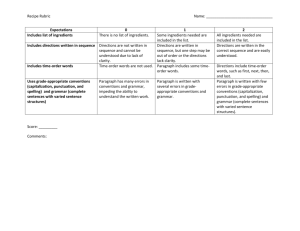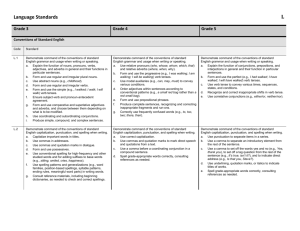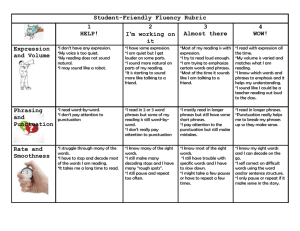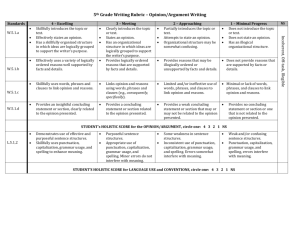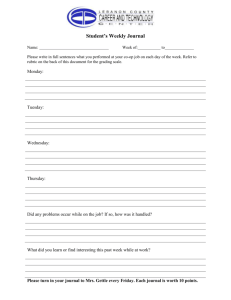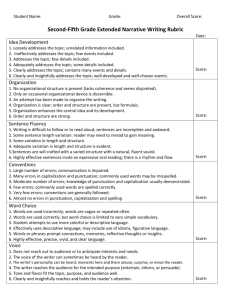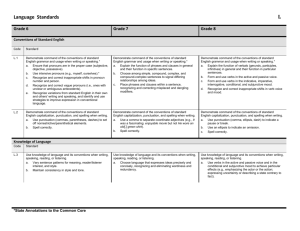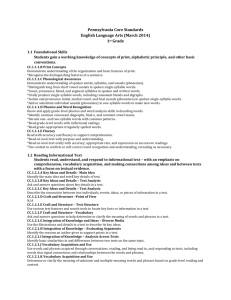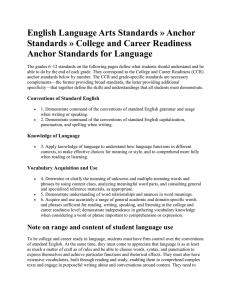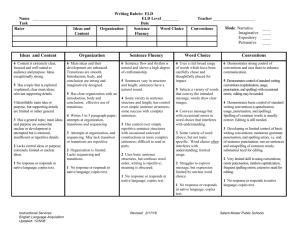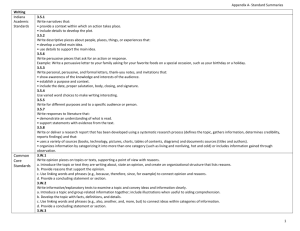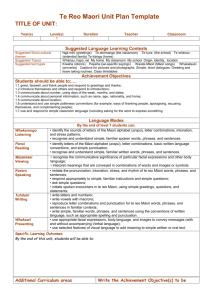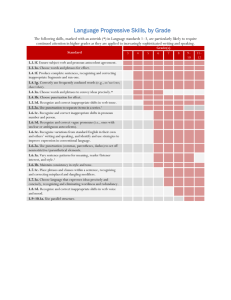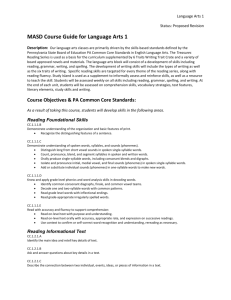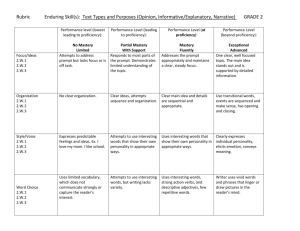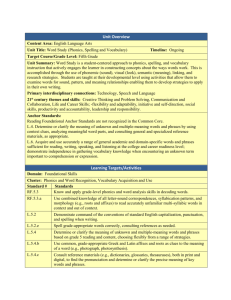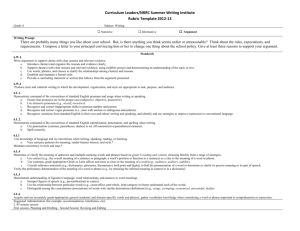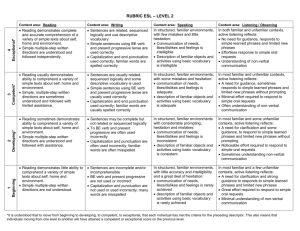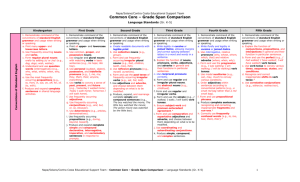Language (L) - Graves County Schools
advertisement
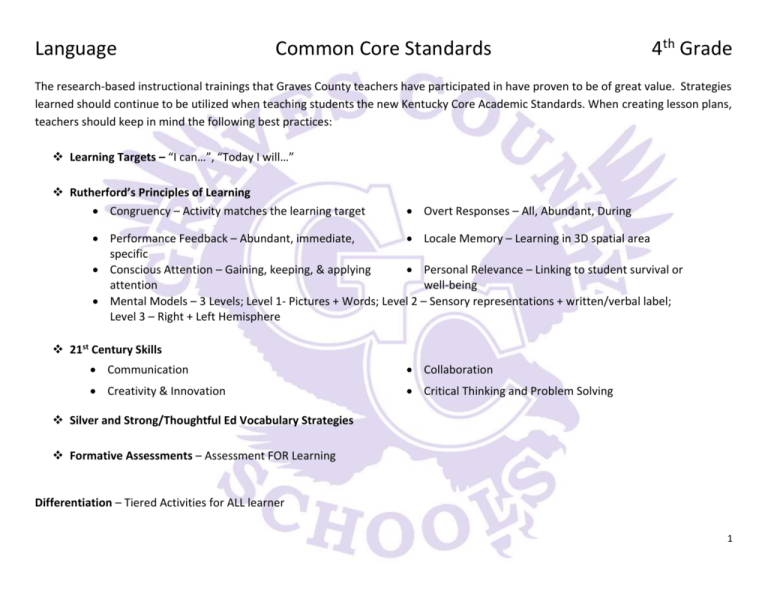
Language Common Core Standards 4th Grade The research-based instructional trainings that Graves County teachers have participated in have proven to be of great value. Strategies learned should continue to be utilized when teaching students the new Kentucky Core Academic Standards. When creating lesson plans, teachers should keep in mind the following best practices: Learning Targets – “I can…”, “Today I will…” Rutherford’s Principles of Learning Congruency – Activity matches the learning target Overt Responses – All, Abundant, During Performance Feedback – Abundant, immediate, Locale Memory – Learning in 3D spatial area specific Conscious Attention – Gaining, keeping, & applying Personal Relevance – Linking to student survival or attention well-being Mental Models – 3 Levels; Level 1- Pictures + Words; Level 2 – Sensory representations + written/verbal label; Level 3 – Right + Left Hemisphere 21st Century Skills Communication Collaboration Creativity & Innovation Critical Thinking and Problem Solving Silver and Strong/Thoughtful Ed Vocabulary Strategies Formative Assessments – Assessment FOR Learning Differentiation – Tiered Activities for ALL learner 1 Language Common Core Standards 4th Grade Language (L) Common Core Standard Key Ideas and Details 4.L.1 Demonstrate command of the conventions of standard English grammar and usage when writing or speaking. a) Use relative pronouns (who, whose, whom, which, that) and relative adverbs (where, when, why). b) Form and use the progressive (e.g., I was walking; I am walking; I will be walking) verb tenses. c) Use modal auxiliaries (e.g., can, may, must) to convey various conditions. d) Order adjectives within sentences according to conventional patterns (e.g., a small red bag rather than a red small bag). e) Form and use prepositional phrases. f) Produce complete sentences, recognizing and correcting inappropriate fragments and run-ons. g) Correctly use frequently confused words (e.g., to, too, two; there, their). 4.L.2 Demonstrate command of the conventions of standard English capitalization, punctuation, and spelling when writing. a) Use correct capitalization. b) Use commas and quotation marks to mark direct speech and quotations from a text. c) Use a comma before a coordinating conjunction in a compound sentence. d) Spell grade-appropriate words correctly, consulting references as needed. Vocabulary Constructive Responses Technology/Activities Grading Period Tested on IOWA: Usage and Expression: Nouns/Pronouns/Modifiers Verbs Conciseness and Clarity Organization of Ideas Appropriate Use Tested on IOWA: Capitalization: Names and Titles Dates and Holidays Place Names Organizations and Groups Writing Conventions Overcapitalization/ Correct Cap. Punctuation: End Punctuation Comma 2 Language Common Core Standards 4th Grade Apostrophe/Quotes/ Colon/Semi Correct Punctuation Spelling: Root Words Words with Affixes Correct Spelling Knowledge of Language 4.L.3 Use knowledge of language and its conventions when writing, speaking, reading, or listening. a) Choose words and phrases to convey ideas precisely. b) Choose punctuation for effect. c) Differentiate between contexts that call for formal English (e.g., presenting ideas) and situations where informal discourse is appropriate (e.g., small-group discussion). Vocabulary Acquisition and Use 4.L.4 Determine or clarify the meaning of unknown and multiple-meaning words and phrases based on grade 4 reading and content, choosing flexibly from a range of strategies. a) Use context (e.g., definitions, examples, or restatements in text) as a clue to the meaning of a word or phrase. b) Use common, grade-appropriate Greek and Latin affixes and roots as clues to the meaning of a word (e.g., telegraph, photograph, autograph). c) Consult reference materials (e.g., dictionaries, glossaries, thesauruses), both print and digital, to find the pronunciation and determine or clarify the precise meaning of key words and phrases. 3 Language Common Core Standards 4th Grade 4.L.5 Demonstrate understanding of figurative language, word relationships, and nuances in word meanings. a) Explain the meaning of simple similes and metaphors (e.g., as pretty as a picture) in context. b) Recognize and explain the meaning of common idioms, adages, and proverbs. c) Demonstrate understanding of words by relating them to their opposites (antonyms) and to words with similar but not identical meanings (synonyms). 4.L.6 Acquire and use accurately grade-appropriate general academic and domain-specific words and phrases, including those that signal precise actions, emotions, or states of being (e.g., quizzed, whined, stammered) and that are basic to a particular topic (e.g., wildlife, conservation, and endangered when discussing animal preservation). 4
